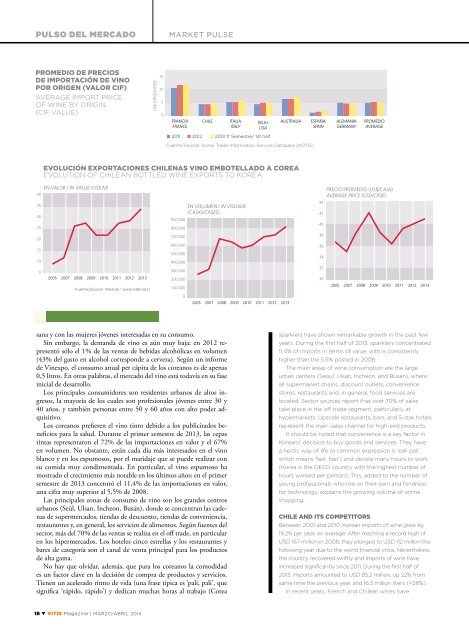rev_57
rev_57
rev_57
Create successful ePaper yourself
Turn your PDF publications into a flip-book with our unique Google optimized e-Paper software.
pulso del mercado<br />
market pulse<br />
Promedio de Precios<br />
de Importación de vino<br />
por Origen (Valor CIF)<br />
Average Import Price<br />
of Wine by Origin<br />
(CIF Value)<br />
US$ litros/Liters<br />
15<br />
10<br />
5<br />
0<br />
francia<br />
France<br />
chile<br />
italia<br />
Italy<br />
EEUU<br />
usa<br />
australia<br />
españa<br />
spain<br />
alemania<br />
germany<br />
promedio<br />
average<br />
n 2011 n 2012 n 2013 1º Semestre/ 1st half<br />
Fuente/Source: Korea Trade Information Service Database (KOTIS).<br />
EVOLUCIóN EXPORTACIONES CHILENAS VINO EMBOTELLADO A corea<br />
EVOLUTION OF CHILEAN BOTTLED WINE EXPORTS TO korea<br />
en valor / In value (US$ m)<br />
40<br />
35<br />
30<br />
25<br />
20<br />
15<br />
10<br />
0<br />
2005 2007 2008 2009 2010 2011 2012 2013<br />
Fuente/Source: Intelvid / www.intelvid.cl<br />
en volumen / In volume<br />
(Cajas/Cases)<br />
900.000<br />
800.000<br />
700.000<br />
600.000<br />
500.000<br />
400.000<br />
300.000<br />
200.000<br />
100.000<br />
0<br />
2005 2007 2008 2009 2010 2011 2012 2013<br />
44<br />
42<br />
40<br />
38<br />
36<br />
34<br />
32<br />
30<br />
PRECIO PROMEDIO (US$/CAJA)<br />
AVERAGE PRICE (USD/CASE)<br />
2005 2007 2008 2009 2010 2011 2012 2013<br />
sana y con las mujeres jóvenes interesadas en su consumo.<br />
Sin embargo, la demanda de vino es aún muy baja: en 2012 representó<br />
sólo el 1% de las ventas de bebidas alcohólicas en volumen<br />
(43% del gasto en alcohol corresponde a cerveza). Según un informe<br />
de Vinexpo, el consumo anual per cápita de los coreanos es de apenas<br />
0,5 litros. En otras palabras, el mercado del vino está todavía en su fase<br />
inicial de desarrollo.<br />
Los principales consumidores son residentes urbanos de altos ingresos,<br />
la mayoría de los cuales son profesionales jóvenes entre 30 y<br />
40 años, y también personas entre 50 y 60 años con alto poder adquisitivo.<br />
Los coreanos prefieren el vino tinto debido a los publicitados beneficios<br />
para la salud. Durante el primer semestre de 2013, las cepas<br />
tintas representaron el 72% de las importaciones en valor y el 67%<br />
en volumen. No obstante, están cada día más interesados en el vino<br />
blanco y en los espumosos, por el maridaje que se puede realizar con<br />
su comida muy condimentada. En particular, el vino espumoso ha<br />
mostrado el crecimiento más notable en los últimos años: en el primer<br />
semestre de 2013 concentró el 11,4% de las importaciones en valor,<br />
una cifra muy superior al 5,5% de 2008.<br />
Las principales zonas de consumo de vino son los grandes centros<br />
urbanos (Seúl, Ulsan, Incheon, Busán), donde se concentran las cadenas<br />
de supermercados, tiendas de descuento, tiendas de conveniencia,<br />
restaurantes y, en general, los servicios de alimentos. Según fuentes del<br />
sector, más del 70% de las ventas se realiza en el off trade, en particular<br />
en los hipermercados. Los hoteles cinco estrellas y los restaurantes y<br />
bares de categoría son el canal de venta principal para los productos<br />
de alta gama.<br />
No hay que olvidar, además, que para los coreanos la comodidad<br />
es un factor clave en la decisión de compra de productos y servicios.<br />
Tienen un acelerado ritmo de vida (una frase típica es ‘pali, pali’, que<br />
significa ‘rápido, rápido’) y dedican muchas horas al trabajo (Corea<br />
sparklers have shown remarkable growth in the past few<br />
years. During the first half of 2013, sparklers concentrated<br />
11.4% of imports in terms of value, with is consistently<br />
higher than the 5.5% posted in 2008.<br />
The main areas of wine consumption are the large<br />
urban centers (Seoul, Ulsan, Incheon, and Busan), where<br />
all supermarket chains, discount outlets, convenience<br />
stores, restaurants and, in general, food services are<br />
located. Sector sources report that over 70% of sales<br />
take place in the off trade segment, particularly at<br />
hypermarkets. Upscale restaurants, bars, and 5-star hotels<br />
represent the main sales channel for high-end products.<br />
It should be noted that convenience is a key factor in<br />
Koreans’ decision to buy goods and services. They have<br />
a hectic way of life (a common expression is ‘pali pali’,<br />
which means ‘fast, fast’) and devote many hours to work<br />
(Korea is the OECD country with the highest number of<br />
hours worked per person). This, added to the number of<br />
young professionals who live on their own and fondness<br />
for technology, explains the growing volume of online<br />
shopping.<br />
CHILE AND ITS COMPETITORS<br />
Between 2001 and 2010, Korean imports of wine grew by<br />
19.2% per year, on average. After reaching a record high of<br />
USD 167 million in 2008, they plunged to USD 112 million the<br />
following year due to the world financial crisis. Nevertheless,<br />
the country recovered swiftly and imports of wine have<br />
increased significantly since 2011. During the first half of<br />
2013, imports amounted to USD 85.2 million, up 22% from<br />
same time the p<strong>rev</strong>ious year, and 16.3 million liters (+28%).<br />
In recent years, French and Chilean wines have<br />
18 ▼ Vitis Magazine l marzo/abril 2014


